#everest panorama view trek
Explore tagged Tumblr posts
Text
Everest View Trek - 8 Days | Everest Panorama View Trek
Everest View Trek is the easy & short 8 days trek that you can embark on to explore stunning views of Mt. Everest. Trek from Lukla to Phakding to Namche Bazaar.
For more info: https://nepalguidetrekking.com/trip/everest-view-trek
#Everest #View #Trek, #everestpanoramaviewtrek

0 notes
Text
Everest View Trek
Everest View Trek is the best way to see the Mount Everest and other Himalayas view. You will experience the sherpa culture, buddhist monasteries, Lukla and Namche Bazar, Flora and Fauna and wild animals of Sagarmatha National park.

#everest view trek#Everest Panorama trek#7 days Everest View Trek#everest trekking#short everest trek
0 notes
Text
Over the Amphu, Into the Khumbu (P1)
Part 3 of Jake Norton's blog
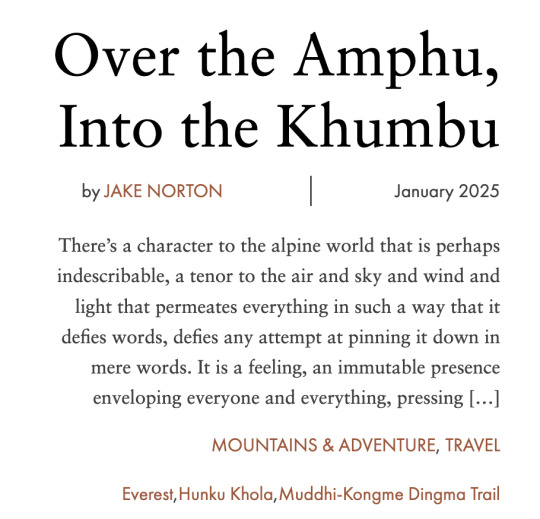

There’s a character to the alpine world that is perhaps indescribable, a tenor to the air and sky and wind and light that permeates everything in such a way that it defies words, defies any attempt at pinning it down in mere words. It is a feeling, an immutable presence enveloping everyone and everything, pressing down upon not in a negative, but in a profoundly positive way, a way that reminds without any pretense subtlety that we humans are but tiny specks, simple visitors to this wild realm, creatures of such little consequence to the magnificence and omnipotence of the surrounding vastness that we might as well not even be there.

Sam Heughan and Jhanak Karki trek through the Upper Hunku Valley near Seto Pokhari.
And yet there we were, awestruck.
Leaving the windswept hamlet of Kongme Dingma, our team entered into that world immediately. A short climb from the valley brought brought us to panoramic views of the high peaks: Chamlang (the ever present), Kali Himal (AKA Chota Ri), Baruntse, and far in the distance, the imposing South Faces of Lhotse and Nuptse with Everest peeking out just above. Stunning.
From here upward, the Upper Hunku Valley is reminiscent of Khumbu - broad valleys and rushing water flanked on all sides by impossibly high, jagged massifs - but with one huge difference: no people. Up here, unlike Khumbu, there are no villages, no lodges, no trekkers or helicopters, no cell service. In the high Hunku it was as it had been for days before: just us.

Jhanak, Aashish, and Sam play some intense Rummy 500 trailside.

Chamlang and camp, Upper Hunku Valley, Nepal.

Seto Pokhari catches the reflection of Lhotse, Nuptse, and Peak 6764.

Hem Rai enjoys the views in the Upper Hunku.

Seto Pokhari and the peaks of the Upper Hunku Valley.

Paanch Pokhari luminous in the Upper Hunku.
We had three days in the upper valley, following a faint-but-solid trail that meandered along the turquoise Hunku; its glacial waters - beginning in the lakes of Seto and Paanch Pokhari - carry fine sediments ground out of the high peaks, sediments so tiny (just a few microns in diameter) they remain suspended in the water, absorbing most blue light and reflecting back the natural green of the water (with some blue) - plus the natural sunlight - creating an otherworldly vividness in this stark world.
With each step upward, altitude records continued to be set for Sam and Jhanak, and new view emerged for us all. Here a peek of Makalu, there a new aspect of Kangtega, Peak 41, Chamlang, or any of the countless unnamed jags of the valley. The toils of altitude, the panting lungs and burning legs, all dissipate under the spell of the high country.
Eventually we made it to our final camp, a beautiful scree shoulder above the upper Paanch Pokhari (paanch means five, and pokhari means pond or small lake) and just below Kami Himal/Chota Ri and the Amphu Laptsa. The December cold set upon us quickly, so we made it a brief evening with heartfelt goodbyes to most of our team: going over the pass would only be Sam, Jhanak, Tshering, Harka, and I along with three porters, Manbir Rai, Hem Rai, and Septa Rai, while the rest would trek together back to Chheskam.

Peak 6764 rises high above the Hunku.
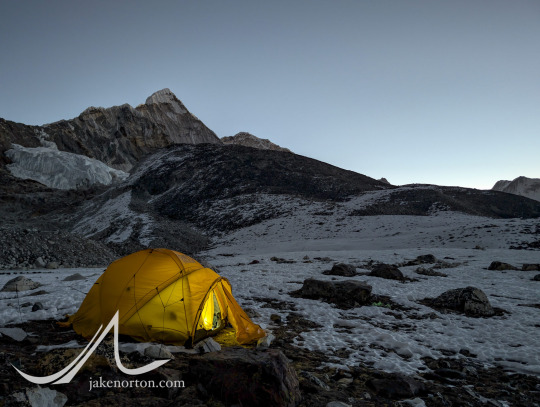
Kali Himal (Chota Ri) stands guard over high camp and Sam's tent in the Hunku

The team at dawn: Jhanak Karki, Sam Heughan, Tshering Dorje Sherpa, and Harka Kulung Rai.

Sam Heughan moving up high on the south side of the Amphu Laptsa.

Panorama from midway up the Amphu Laptsa, looking south down the Hunku Valley.

The wild summit of Peak 41 rises into the blue sky.

Sam Heughan making his way up the Amphu Laptsa at about 18,900 feet.
A short night with a full moon found us awake at 5:30 AM ready to begin the climb. It’s not a long one up to the Amphu Laptsa - an ascent of just 1,200 feet - but that is compounded by the altitude plus a technical descent and long walk on the other side making for a solid day. And, a primary rule of the mountains is to always leave a window of daylight just in case: hence, an early start.
From camp, the route up the Amphu is interesting, but never desperate or dangerous. Steep slabs offer significant exposure, but are well-protected by via ferrata-style fixed lines added in recent years. After about 1.5 hours, we crested the prayer-flag crowned top and allowed ourselves time to savor the hard-earned view. From the Amphu, the landscape seems of a dream, and unreal mosaic of spires and walls, glaciers and lakes, blue skies and solitude forever. As I always do, I placed a few kathas at the highest point, offerings of blessings and remembrance for my family, my friends, for humanity, for our world, uttered a silent prayer to any divine presence nearby, and returned to our group a couple dozen feet below.
It was then that a problem arose. I’d like to say it was someone else’s, but ultimately as leader the bock stops with me, so it was mine, and I own it. During trip planning, I had insisted that all members planning to cross the Amphu - and especially any porters - must have traction devices (crampons or microspikes) at minimum. While mountain-hardy and well-heeled, our porters Manbir, Hem, and Septa are still of course human, prone to error and missteps. And, on the descent from the Amphu, an error or misstep will quite quickly lead to a cartwheeling 1,200 foot fall to the valley below. In short, death.

Sam Heughan atop the Amphu Laptsa, pointing to Everest in the distance.

360-degree panorama from the top of the Amphu Laptsa.

Footprints lead down into the abyss, looking east from the top of the Amphu Laptsa.

A katha I placed on top of the Amphu Laptsa.

Steep slopes on the north side of the Amphu Laptsa.

Jhanak Karki (left) and Sam Heughan (right) high on the Amphu Laptsa Pass in Nepal. Lhotse and Everest are the primary peaks in the background.
Obviously not a possibility I was willing to even entertain, so I was more than surprised to look down and see them beginning to descend fixed lines without any traction, only Chinese sneakers on polished snow and ice. Yikes.
After letting my stomach stop flip-flopping for a moment, I quickly put on my crampons and rushed down to our porters, our friends, and began making the situation right. There was no way to magically make traction devices appear, so I did what was my only option: made them drop their loads - I’d shuttle the gear to safety - and help them descend safely, chopping out steps where needed, having them stand on my boots when necessary, and hold on to both me and the fixed ropes for safety. It was a long and tedious process taking the better part of 1.5 hours (along with lowering the loads down a particularly steep section with help from Tshering and Harka), but eventually we got it done.
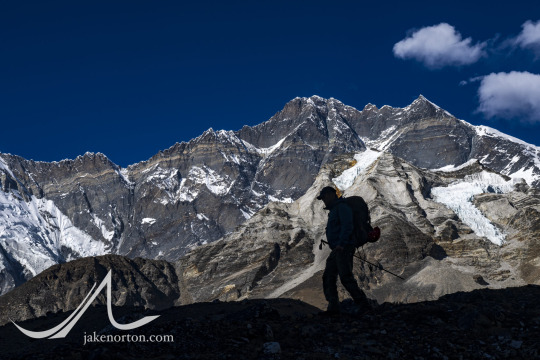
Sam Heughan silhouetted against the South Face of Lhotse (and Imjatse barely discernable in the foreground).
As another twist, in my haste to ensure the porters were safe, I had left Sam and Jhanak atop the pass with no more than a Schwarzenegger-esque “I’ll be back” to keep them safely in place. Fortunately, I know both of them well enough to know they’d be fine: the top of the pass is safe, the skies were clear, and both are level-headed people. Sure enough, when I got back up, they were concerned, but no worse for wear. We began the descent, with both Sam and Jhanak making it look like second nature, clipping fixed lines, rappelling steep slopes, and using crampons and technical equipment without issue.
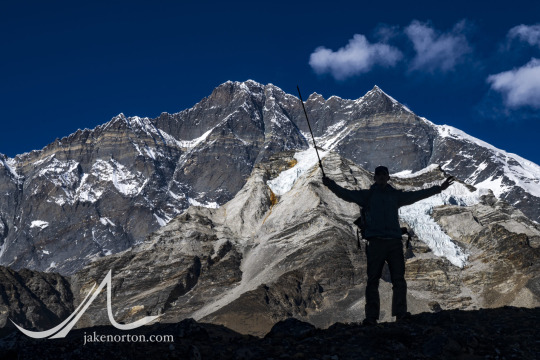
Sam celebrating in the valley above Chukhung.

Amphulaptsa Tsho below the north face of Ama Dablam.

Tawoche and Cholatse in fdaing light above the village of Chukhung.
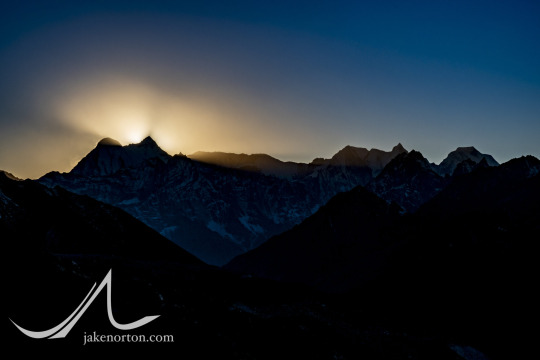
Twilight on the high peaks.
With a sigh of relief, we reached the valley floor - all eight of us - a couple hours later, all in one piece. The hazard was behind, the stress abated, and all we had left was a 6-mile stroll through mesmerizing country to the village of Chukhung and our first roof and bed in 10 days. This last bit was uneventful-but-sublime, softening light warming the massif of the Lhotse-Nuptse wall as we strolled, alone, down valley.
We’d now shifted gears in a big way, we’d left the solitude and remoteness of the Hunku for the relative modernity and front-country-ness of the Khumbu. I won’t say it was bad - I’ve made many a trip up the Khumbu since my first in 1993, and it’s always wonderful, always showing its charms. But, after being utterly immersed in a landscape for some time with no distractions, nothing but us and the mountains, sky, and wind, it was more than a bit jarring for us all to reenter the world once again, phones pinging and helis overhead.

Harka rests at a chorten near Dingboche.

Pack horses rest at memorial chortens for fallen climbers at Memorial Hill above Tukhla.

Our gang!
See part 2 here
36 notes
·
View notes
Text
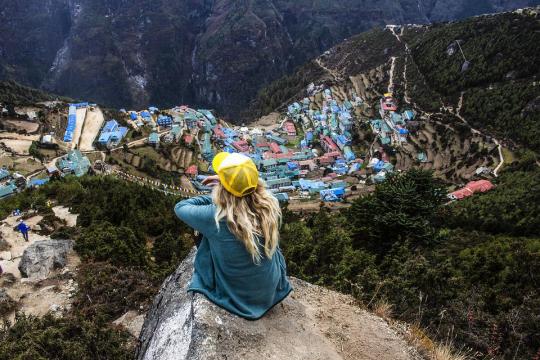
Everest Panorama Trek is a perfect trekking package who have less time but still want to have a close view of Mount Everest. This Everest Panorama view trekking provides a close-up look at the rich culture of the friendly Sherpa community of Nepal.
#adventurehimalayacircuit#nepalhimalayastrekking#trekking#everestpanoramatrek#everestpanoramatrekcost#everestpanoramatrekitinerary#everestpanoramatrekpermit#everestpanoramatrekguide#travel#natural#naturallover#himalayas#photography
11 notes
·
View notes
Video
tumblr
Everest panorama view trek from Tengboche Monastery @nepalgatewaytrekking
#trekking in nepal#adventure#mountain#hikingtrail#guided tours#oneweek#visitnepal#nepal2023#nepalnow#trekking#holiday#nature
7 notes
·
View notes
Text
10 Best Skydiving Places in the World
Planning to tick off skydiving off your bucketlist? It’s time you get out and muster the courage to experience the adrenaline rush and sensation of flying in the air at or beyond 13000 feet above the ground. Check out our list of the most fascinating places to skydive if you are looking for the ideal drop zone with unique scenery to make this adventure experience the most memorable experience of your life.

Dubai, United Arab Emirates
If you crave an extreme adventure on a Middle Eastern holiday, Dubai is the spot to visit. Plunging above the Palm Jumeirah - the stellar sprawling palm tree-shaped artificial islands encircled by the azure Persian Gulf- is an experience you will remember forever. One can also go skydiving in Dubai amid the Arabian deserts, and visitors in UAE spending time in the capital emirate can also experience Skydiving in Abu Dhabi. The Skydive Abu Dhabi tickets are less expensive than those for Skydive Dubai. Still, if scenery is truly important to you, you should unquestionably go to the Palm Jumeirah drop zone.
Franz Josef and Fox Glacier, New Zealand

The natural beauty of New Zealand and its reputation as the "Adventure destination of the world" place it among the top destinations for those seeking an adrenaline rush. The Franz Josef and Fox Glacier in New Zealand's South Island are where you can experience gusty, chilly winds whipping your face as you float above breath-taking glacial vistas. According to surveys, the Skydive Franz Josef and Fox Glacier are presently the most picturesque drop zone in the world.
Sydney Wollongong, Australia

Australia is one of the most well-known skydiving destinations in the world, and there are many drop zones to choose from. Among them, Sydney Wollongong has received positive feedback from skydiving enthusiasts. It is one of the world's most famous places for skydiving and lets you experience a thrilling rush of adrenaline while admiring Sydney’s harbour, city, and skyline. Take to the skies and fly instead of going to the Sydney beaches on your next visit!
Le Marche, Italy
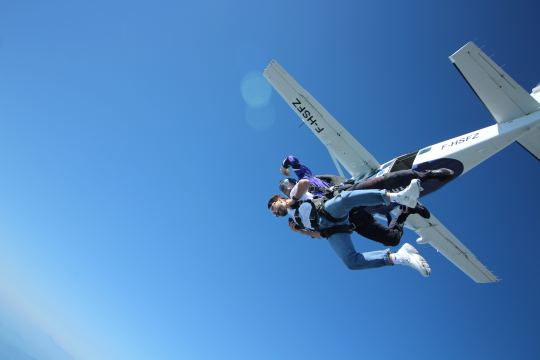
Le Marche is a spectacular spot to get high on adrenaline and enjoy a freefall amid Italy’s Toscana scenery. Get the vantage point to tumble down and soar on top of the Adriatic Sea’s azure waters and cliffs of Apennine mountains.
Pattaya, Thailand
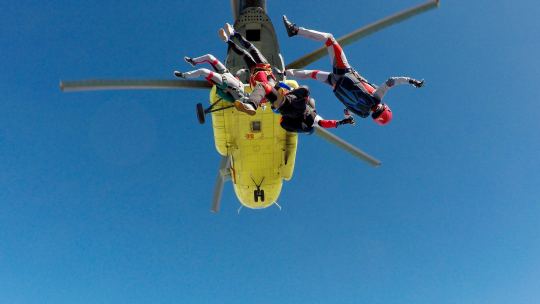
Thailand's tropical landscape attracts beachgoers and water sport enthusiasts to its regions; however, Pattaya, one of Thailand's most popular tourist spots, welcomes you to gear up for a skydiving experience. The Skydive Pattaya offers a tandem skydiving experience over the beautiful Nong Kho Reservoir in Chonburi.
Grand Canyon, United States of America

The Grand Canyon is a famous natural wonder, but getting a bird's eye view of its stunning splendour is an unrivaled experience. Head for the adventure of a lifetime when you sign up for a skydiving experience at this gorgeous, red, rocky canyon.
Interlaken, Switzerland
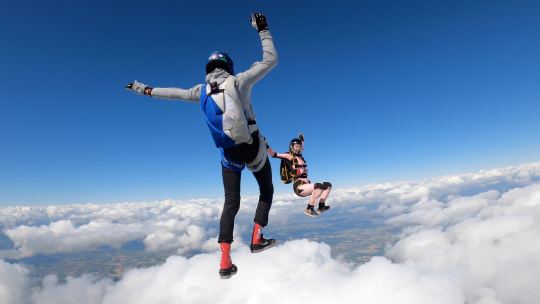
Nothing compares to Interlaken's high-definition hues of Swiss alpine panoramas. This region of Switzerland, well-known for its ski resorts, gondola rides, and scenic funiculars, also provides an unconventional way to take in its breathtaking scenery by skydiving in the Swiss Alps. If you are an adrenaline junkie and are off to Switzerland, don't miss the chance to skydive in Swiss!
Mount Everest, Nepal

There is another way to see the summit of Mount Everest that does not include difficult treks. All you need is the courage to jump out of a plane, and you can fly above the highest mountain in the world! Yes! Mount Everest is also a drop zone for skydiving and is one of the most dizzying, thrilling adventures to witness in your lifetime!
Seville, Spain
Fly high leisurely above Seville, then prepare for a freefall while taking in the incredible views of southern Spain! Seville is among the best places to visit if you like extreme adventures. Skydiving here is a unique, once-in-a-lifetime experience you should enjoy if you love outdoor adventures!
Maldives
You can explore the underwater realm while on a leisurely Maldives holiday. How about extending the adventure by having an over-the-water, airborne adventure? Sign up with SkyDive Maldives to enjoy this exhilarating experience. As you fly above its pristine isles, the aerial views of Maldives is a moment you will cherish for a long time.
Conclusion
Skydiving is the ultimate experience for those seeking an amalgam of the euphoria of soaring in the air and amazing panoramas from above. The abovementioned ten skydiving destinations take you on an extraordinary journey if you seek the ultimate adrenaline rush. From the world-famous Grand Canyon and the exquisite Swiss Alps to the pristine Maldives and the magnificent terrain of New Zealand, these drop zones let you conquer fear, take a step ahead, and feel the thrill of falling amid some of the world's most diverse and fascinating panoramas. So, for those who dare to take the plunge, the world's best skydiving places await, eager to offer an unforgettable and life-changing experience. If you still want to soar but don't want to jump out of a plane, there are plenty of hot air balloon rides around the world to check out, offering a mild thrill of gliding above exquisite panoramas.
2 notes
·
View notes
Text
12 Days Mardi Himal Trek: An Ultimate Guide to Adventure and Serenity
The Mardi Himal Trek is a hidden gem in Nepal’s vast tapestry of trekking routes, offering an extraordinary blend of adventure and tranquility. Nestled in the lap of the majestic Annapurna range, this trek takes you through lush forests, charming villages, and to the mesmerizing Mardi Himal High Camp. It’s a journey that allows you to connect with nature while experiencing the rich cultural heritage of the region.
If you’re planning your next trekking adventure, this 12 day Mardi Himal Trek guide will prepare you for an unforgettable journey.

Overview of the 12 Days Mardi Himal Trek
The Mardi Himal Trek offers panoramic views of some of Nepal's most iconic peaks, including Mardi Himal, Machapuchare (Fishtail), Annapurna South, and Himchuli. Unlike the more crowded Annapurna Base Camp or Everest Base Camp treks, this route remains relatively unexplored, providing serenity and solitude for trekkers.
The trek gradually ascends to an altitude of 4,500 meters at Mardi Himal Base Camp, with stops at picturesque locations like Mardi Himal High Camp and Low Camp. The entire journey can be completed in 12 days, making it perfect for travelers seeking a moderate adventure without sacrificing comfort or scenery.
Itinerary: A Day-by-Day Breakdown
Day 1: Arrival in Kathmandu Your journey begins in Nepal’s bustling capital, Kathmandu. Explore UNESCO World Heritage sites or stock up on last-minute trekking essentials.
Day 2: Drive to Pokhara (827m) Take a scenic drive to Pokhara, the gateway to the Annapurna region. Relax by the serene Phewa Lake and soak in the stunning views of the mountains.
Day 3: Drive to Kande and Trek to Deurali (2,125m) A short drive to Kande marks the starting point of the trek. Hike through rhododendron forests to reach Deurali, a tranquil village.
Day 4: Trek to Forest Camp (2,520m) The trail takes you deeper into dense forests filled with oak, maple, and rhododendron trees, where bird songs accompany you.
Day 5: Trek to Low Camp (2,970m) As you ascend, the landscape changes. Low Camp provides your first glimpse of Machapuchare’s majestic peak.
Day 6: Trek to Mardi Himal High Camp (3,580m) This is one of the most exciting days as you reach Mardi Himal High Camp. The climb is moderate, but the sweeping views of the Annapurna range will leave you spellbound.
Day 7: Explore Mardi Himal Base Camp (4,500m) Begin early to hike to Mardi Himal Base Camp. The sunrise paints the snow-capped peaks in shades of gold. Take your time soaking in the panoramic vistas.
Day 8: Descend to Low Camp The return journey begins with a descent to Low Camp. The trek back allows you to appreciate the route’s changing beauty from a different perspective.
Day 9: Trek to Siding Village (1,750m) Pass through traditional Gurung villages, offering a glimpse of Nepalese mountain culture and hospitality.
Day 10: Drive back to Pokhara From Siding, take a scenic drive back to Pokhara and enjoy your well-earned rest.
Day 11: Return to Kathmandu Drive back to Kathmandu, reliving memories of the trek while traveling through Nepal’s beautiful countryside.
Day 12: Departure With your heart full of memories and your camera brimming with breathtaking photos, bid farewell to Nepal.
What Makes Mardi Himal Trek Special?
Stunning Views of the Himalayas The trek offers unparalleled views of Mardi Himal and Machapuchare. The highlight is the breathtaking panorama from Mardi Himal High Camp, where the peaks seem almost close enough to touch.
Relatively Untouched Path Unlike heavily trafficked routes, this trail provides peace and tranquility, allowing trekkers to immerse themselves in the pristine environment.
Cultural Encounters The journey passes through several Gurung and Magar villages, where you can experience traditional Nepalese hospitality, cuisine, and customs.
Diverse Landscapes From subtropical forests to alpine meadows, every step of the Mardi Himal trekking trail offers diverse and picturesque scenery.
Preparing for the Mardi Himal Trek
Best Time to Trek The two main trekking seasons are:
Spring (March to May): Expect blooming rhododendrons and clear skies.
Autumn (September to November): Experience crisp weather and spectacular views.
Physical Fitness This trek is categorized as moderate, but the altitude (up to 4,500m) can be challenging. Regular cardio and strength training will prepare you for the journey.
Packing Essentials
Layers for varying temperatures
Sturdy hiking boots
Trekking poles
Water purification tablets
Sunscreen and sunglasses
Altitude Awareness
The trek’s altitude gain is steady but gradual. The highest point, Mardi Himal Base Camp (4,500m), may pose challenges like mild altitude sickness. Stay hydrated, pace yourself, and acclimatize as necessary to enjoy the trek safely.
Tips for a Memorable Trek
Start Early: Witness the magical sunrise on the mountains.
Hire a Guide or Porter: Their expertise enhances your experience and supports the local economy.
Respect the Environment: Follow Leave No Trace principles to preserve the pristine landscapes.
Embrace Local Culture: Engage with locals, try traditional foods, and learn about their customs.
Conclusion
The 12 Days Mardi Himal Trek is a gateway to an unparalleled Himalayan experience. With breathtaking views, rich cultural encounters, and the serenity of less-traveled paths, it’s a journey that remains etched in the heart of every trekker. Whether you’re an avid adventurer or a first-time trekker, the Mardi Himal trekking experience promises memories that last a lifetime.
So, pack your gear and set forth on this incredible adventure to the Mardi Himal High Camp – a trek where nature’s splendor meets human endurance and spirit.
0 notes
Text
Lobuche Peak Climbing: A Thrilling Himalayan Adventure
Lobuche Peak Climbing offers an incredible mountaineering experience in the famous Everest region of Nepal. This challenging climb takes adventurers to an impressive height of 6,119 meters (20,075 feet), providing a perfect introduction to high-altitude mountaineering.
Quick Climbing Facts
Peak elevation: 6,119 meters
Difficulty level: Moderate to technical
Success rate: 60-65%
Total expedition duration: 16-19 days
Best climbing seasons: April-May and September-November
Statistical Breakdown:
Annual climbers: Approximately 1,200
Successful summits: Around 750-800 per year
Average climbing time to summit: 6-8 hours
Technical sections: 2-3 challenging pitches
The expedition combines trekking and technical climbing, requiring basic mountaineering skills. Climbers typically start from Lukla, following the classic Everest Base Camp route before branching towards Lobuche Peak.
Preparation Requirements:
Physical training: 3-4 months recommended
Fitness focus:
Cardiovascular endurance
Strength training
High-altitude conditioning
Estimated cost: $2,300 to $3,800 per person
Essential Climbing Gear:
Climbing harness
Crampons
Ice axe
Climbing helmet
High-altitude climbing boots
Thermal layers
Climbing ropes and carabiners
Safety Highlights:
Professional mountain guides
Small group sizes (4-8 climbers)
Comprehensive safety equipment
Continuous weather monitoring
Acclimatization days included
Emergency evacuation plans
Physical and Technical Challenges:
Steep snow and ice sections
Glacier crossing
Fixed rope techniques
High-altitude environment
Technical climbing skills needed
Climbers will experience:
Breathtaking Everest region views
Close-up mountain panoramas
Interaction with local Sherpa communities
Personal mountaineering achievement
Challenging physical and mental test
This adventure combines technical climbing, stunning landscapes, and personal challenge into an unforgettable Himalayan experience. You'll push your limits, learn new skills, and create memories that last a lifetime.
Recommended for:
Experienced trekkers
Basic mountaineering skills
Good physical fitness
Age range: 20-45 years
Strong mental determination
A dream for adventure seekers and mountain enthusiasts, Lobuche Peak Climbing offers a perfect blend of challenge, beauty, and personal growth.
0 notes
Text
Everest Base Camp Trek: A Complete Guide to the Ultimate Himalayan Adventure

The Everest Base Camp Trek is one of the most iconic and sought-after trekking adventures in the world. For anyone who dreams of standing in the shadow of the world’s tallest mountain, this trek is a must-do. As someone who has experienced the thrill of trekking in the Everest region, I can say that it’s more than just a physical challenge – it’s an unforgettable journey through breathtaking landscapes, unique Sherpa culture, and the grandeur of the Himalayas.
What Makes the Everest Base Camp Trek Special?
The Everest Base Camp Trek offers the unique opportunity to trek to the foot of Mount Everest (8,848 meters/29,029 feet), surrounded by towering peaks, glaciers, and the vibrant culture of the Sherpa people. Along the way, trekkers pass through picturesque villages, monasteries, and lush forests, all while acclimatizing to the altitude.
The trek is not just about reaching Everest Base Camp, it’s about experiencing the journey – from the vibrant market of Namche Bazaar to the awe-inspiring Kala Patthar viewpoint, where the views of Everest and its neighboring peaks are simply unbeatable.
Starting Your Trek: From Lukla to Namche Bazaar
Your adventure begins with a flight from Kathmandu to Lukla, a small town with a dramatic airport that serves as the gateway to the Everest region. The 30-minute flight offers stunning aerial views of the Himalayas, and once you land in Lukla, the trek officially starts.
From Lukla, the route follows the Dudh Koshi River, with the first stop being Phakding, a charming village where trekkers can rest and acclimatize. The next day, the trail leads to Namche Bazaar, the bustling Sherpa town and the main trading hub of the region. Namche is a great place to rest and acclimatize, offering opportunities to explore local markets, visit the Sherpa Museum, and enjoy views of Everest, Lhotse, and other surrounding peaks.
The Trek to Tengboche and Dingboche
From Namche, the trail heads towards Tengboche, home to the Tengboche Monastery, one of the most important Buddhist monasteries in the region. Here, you can take a moment to soak in the peace and serenity of the area, with sweeping views of Everest, Lhotse, and Ama Dablam.
The journey continues through the Imja Valley towards Dingboche, a village that sits at an altitude of 4,410 meters (14,469 feet). Dingboche is an ideal place for acclimatization, with stunning views of Mount Makalu and other surrounding peaks. The trek from Namche to Dingboche takes trekkers through alpine forests, rhododendron groves, and yak pastures.
Reaching Everest Base Camp
As you trek further into the Everest region, the landscapes become more barren and dramatic. The air gets thinner, and the altitude becomes more challenging. The next stop is Lobuche, a small settlement nestled at 4,940 meters (16,210 feet), which marks the last major stop before reaching Everest Base Camp.
From Lobuche, the final stretch to Everest Base Camp is an exciting and challenging day of trekking. The trail takes you through rocky terrain and across glaciers, with the majestic Khumbu Icefall in the distance. Reaching Everest Base Camp itself is a moment of triumph, as trekkers stand at the base of the world’s tallest mountain, gazing up at the immense, towering peak.
The Final Push: Kala Patthar
While Everest Base Camp is the ultimate destination, the best panoramic views of Mount Everest are from Kala Patthar (5,545 meters/18,192 feet). This summit is a short but steep hike from Gorak Shep, the last village before Base Camp. From Kala Patthar, you’ll be treated to one of the most spectacular views in the world – a 360-degree panorama of Everest, Lhotse, Nuptse, and other peaks in the Khumbu region.
The early morning trek to Kala Patthar offers the best light for photographs, with the sun casting a golden glow on the snow-capped peaks.
Acclimatization and Safety
Due to the high altitude, proper acclimatization is crucial for completing the Everest Base Camp Trek. The trek follows a gradual ascent, with rest days in key places like Namche Bazaar, Dingboche, and Lobuche. This allows your body time to adjust to the thinning air and reduces the risk of altitude sickness.
It’s also essential to stay hydrated, eat well, and listen to your body throughout the trek. It’s normal to feel fatigued or breathless at higher altitudes, but if you experience symptoms of altitude sickness, such as dizziness, headaches, or nausea, it’s important to descend immediately.
Best Time to Trek Everest Base Camp
The best times to trek to Everest Base Camp are during the spring (March to May) and autumn (September to November) seasons. These months offer stable weather, clear skies, and moderate temperatures, making the trek more enjoyable. Winter can be too cold, and summer brings monsoon rains, which can make the trek challenging.
Conclusion
The Everest Base Camp Trek is a once-in-a-lifetime adventure that takes you to the heart of the Himalayas. From the bustling villages of Namche Bazaar to the tranquil beauty of Everest Base Camp, this trek offers an unparalleled experience of the mountains, culture, and spirit of Nepal. Whether you’re an experienced trekker or a first-timer, the trek to Everest Base Camp is a journey that will stay with you forever, leaving you with unforgettable memories and a deeper appreciation for the majestic Everest region.
0 notes
Text
Trekking Packages to the Majesty of the Himalayas: Explore the Everest Region
Everest Region - popularly known as the Khumbu Region-is the utmost dream destination for any trekker, adventurer, and nature lover. It hosts Mt. Everest at 8,848.86m above sea level, the highest mountain in the world that boasts breathtaking views of nature with thrilling adventure, combined with an exotic cultural experience. Whether you’re an experienced trekker or visiting for the first time, the trekking packages available in the Everest region are designed to suit a variety of interests, fitness levels, and schedules. This article highlights some of the most popular trekking packages, including the increasingly popular heli tours, which offer a stunning aerial view of this magnificent landscape.
Popular Trekking Packages in the Everest Region
1. Everest Base Camp Trek
It's one of the most famous treks around the world, the EBC Trek. This takes you to such breathtaking destinations-from picturesque Sherpa villages, lively rhododendron forests, up to extreme altitudes leading one to reach beneath the tallest peak of Earth, Everest Base Camp.
• Duration: 12 - 14 Days
• Grade: Moderate to Challenging
• Highlight:
+ Panoramic view of Mt. Everest and other adjacent mountains of Lhotse, Nuptse, Ama Dablam.
o Day at Namche Bazaar: a bustling gateway to the Khumbu region.
o Tengboche Monastery Visit: a retreat for spiritual activities with breathtaking panoramic views of peaks around it.
2. Everest Base Camp Trek via Gokyo Lakes
This trek encompasses both the classic Everest Base Camp route and the tranquil beauty of Gokyo Lakes for the adventurers who would love to make a difference with landscape variability and challenge of another kind. This also comprises the ascent of Gokyo Ri, from where the sight of the panoramic view of Everest and the peaks surrounding is just stunning.
• Duration: 15-18 days
• Difficulty Level: Moderate to Challenging • Highlights: Å No crossing of the demanding Cho La Pass that connects Gokyo Valley to the main EBC route. Å Breathtaking views of turquoise Gokyo Lakes and Ngozumpa Glacier. Å Iconic sunrise from Gokyo Ri for a fresh view of Everest. Å The rewarding feeling of combining two legendary treks into one unforgettable adventure.
3. Gokyo Lakes and Gokyo Ri Trek
Gokyo Lakes Treks are designed for those trekkers who wish to escape into peaceful wildernesses away from hustle-bustle and noises at the trails full of crowd. This is going to be an ideal blend of adventure and tranquil on walking beside glacial lakes and climb of Gokyo Ri for thrilling views.
• Duration: 12-15 days
• Difficulty Level: Moderate
• Attractions/ Highlights:
o Charming Turquoise lakes contrasting in front of the grand Himalayas.
o Panoramic views of Cho Oyu, Makalu, and Everest from the summit of Gokyo Ri.
no The thrilling crossing of Cho La Pass by trekkers extending to EBC.
4. Three Passes Trek
The Three Passes Trek is for experienced trekkers who are up for a challenge. Actually, this trek combines the Everest Base Camp route with the crossing of three high mountain passes: Renjo La, Cho La, and Kongma La.
• Duration: 18-21 days
• Difficulty Level: Challenging
• Highlights:
o Breathtaking views from the high passes.
o Encounters with diverse Himalayan landscapes and cultures.
o A rewarding sense of achievement after completing one of the most demanding treks in Nepal.
5. Everest Panorama Trek
If you’re pressed for time or not quite ready for high-altitude trekking, the Everest Panorama Trek provides a glimpse of the region’s beauty without requiring extensive physical effort.
• Duration: 7-10 days
• Ease Factor: Easy to Medium
• Attractions:
- Great views of Everest and the surrounding peaks at Tengboche.
- Villages like Khumjung and Phakding to take a closer peek at Sherpa culture.
- A comfortable, not very demanding trek.
Heli Tours in the Everest Region
For those who want to see the Everest region without the hassle of trekking, heli tours are a very luxurious and efficient way to do so. This is ideal for travelers with limited time, physical limitations, or those who want to see the Himalayas in a different way.
Everest Base Camp Helicopter Tour
EBC Helicopter Tour is one of the most in-demand options, covering Everest and its surrounding peaks in an incomparable aerial view. The helicopter generally lands at Kala Patthar for close views of Everest.
• Duration: 4-5 hours
• Highlights:
o Aerial views of the Khumbu Icefall, Everest, and other magnificent peaks.
o Having breakfast at the world's highest altitude hotel in Syangboche.
o Easy exploration of the region without any need to trek.
Everest Base Camp Trek with Helicopter Return
Most of them combine the heli tour with trekking, where trekkers can enjoy the hike and return via helicopter. Such combined tours give tourists a chance to enjoy the best of both worlds.
• Common Itinerary: Trek to Everest Base Camp and fly back to Lukla or Kathmandu by helicopter.
• Advantages:
o Save time with a lot of reduction in physical exhaustion.
o Scenic aerial views during a return flight.
Best Season to Trek or Fly in the Everest Region
The best seasons to go for trekking or helicopter tours in the Everest region include:
• Spring (March to May): Crystal clear skies, rhododendrons in bloom, and friendly temperatures make it the most favorite season for trekkers.
• Autumn (September to November): The clear weather and spectacular views of the mountains attract trekkers from all over the world.
Planning Your Everest Adventure: Some Tips
1. Choosing the Right Package: The fitness level, time available, and your interest should all be factored into your decision while selecting either a trekking or helicopter tour package.
2. Acclimatization Properly: In most high-altitude treks, you'll find one or more days are assigned to acclimatize with altitude sickness.
3. Packing Right: Bring proper trekking equipment along with you like warm clothing, hardy boots, and good quality sleeping bags.
4. Guide Employment: Accomplished guides enrich your experience by elevating safety levels.
5. Respect the Culture: The Sherpa people are rich in culture, and one should be respectful of their traditions.
The Everest Region is a powerhouse of adventure, breathtaking scenery, and cultural experiences. Be it the iconic trek to Everest Base Camp, serene Gokyo Lakes, or thrilling helicopter rides; the Himalayas will keep you spellbound. From a variety of trek packages to diverse options for all tastes, this beautiful part of the world has something for everyone. So, buckle up, lace those hiking boots, and march into the most unforgettable venture at the peak of the world.
0 notes
Text
Conquer Nepal’s Iconic Peaks: Island Peak Climbing, Mera Peak Climbing and Lobuche Peak Climbing
Nepal, the ultimate destination for mountain enthusiasts, offers a variety of trekking peaks that provide thrilling adventures and stunning panoramas. Among the most popular climbs are Island Peak Climbing, Mera Peak Climbing, and Lobuche Peak Climbing, each catering to adventurers seeking an exhilarating introduction to Himalayan mountaineering.
Island Peak Climbing: A Gateway to Everest Dreams
Island Peak Climbing is one of Nepal's most famous trekking peaks, located in the Everest region at an altitude of 6,189 meters. Named for its resemblance to an island amidst a sea of ice, this climb is an ideal challenge for aspiring climbers. The journey begins with a trek through the legendary Khumbu Valley, passing iconic landmarks like Namche Bazaar, Tengboche Monastery, and Dingboche. The climb itself involves moderate technical sections, including glacier crossings and a steep headwall to the summit. From the top, climbers are rewarded with awe-inspiring views of Lhotse, Ama Dablam, and Makalu, making the effort truly worthwhile.
Mera Peak Climbing: Nepal’s Highest Trekking Peak
At 6,476 meters, Mera Peak Climbing is the highest trekking peak in Nepal, offering an unforgettable adventure for those seeking high-altitude thrills. Located in the remote Hinku Valley, the trail takes climbers through pristine forests, rugged landscapes, and culturally rich Sherpa villages. The climb is less technical compared to other peaks, making it accessible for climbers with basic mountaineering skills. However, the altitude presents a significant challenge, requiring proper acclimatization. The summit rewards climbers with one of the most spectacular panoramas in the Himalayas, featuring five of the world’s tallest peaks: Everest, Kanchenjunga, Lhotse, Makalu, and Cho Oyu.
Lobuche Peak Climbing: A Thrilling Everest Region Adventure
Lobuche Peak Climbing offers a thrilling mix of trekking and technical climbing. Situated at 6,119 meters in the Everest region, Lobuche Peak has two summits: East and West, with the East being the more commonly climbed. The trek to Lobuche Base Camp follows the classic Everest Base Camp trail, providing a chance to explore Sherpa culture and iconic landmarks. The ascent involves steep snow and ice sections, demanding solid mountaineering skills. From the summit, climbers enjoy breathtaking views of Everest, Nuptse, Pumori, and other towering peaks.
An Unforgettable Himalayan Experience
Whether it’s the technical excitement of Island Peak Climbing, the high-altitude challenge of Mera Peak Climbing, or the rewarding vistas of Lobuche Peak Climbing, these adventures are perfect for climbers looking to test their limits and embrace the grandeur of Nepal’s Himalayas.
0 notes
Text
Everest View Trek - 8 Days | Everest Panorama View Trek

Everest View Trek is the easy & short 8 days trek that you can embark on to explore stunning views of Mt. Everest. Trek from Lukla to Phakding to Namche Bazaar.
For more info: https://nepalguidetrekking.com/trip/everest-view-trek
0 notes
Text
Climbing in Nepal: The Ultimate Adventure for Mountain Enthusiasts
A Land of Infinite Peaks

Nepal is home to some of the most iconic mountains in the world, making it a dream destination for climbers. The Himalayas, with their towering peaks and diverse landscapes, offer countless opportunities for mountaineering adventures. Whether you're a seasoned climber or an ambitious novice, Nepal offers something for every level of expertise, from challenging technical climbs to breathtaking treks that bring you close to the world's tallest peaks.
Climbing in Nepal isn't just about reaching the summit; it’s about the journey—the people, the culture, and the natural beauty you encounter along the way. From the majestic Mount Everest to lesser-known but equally impressive peaks like Island Peak and Mera Peak, Nepal's mountains provide a unique opportunity to experience high-altitude climbing in one of the most beautiful places on earth.
Popular Climbing Peaks
While Mount Everest is the ultimate goal for many, Nepal offers a variety of peaks suited to different skill levels. Some of the most popular and accessible climbing peaks include:
Island Peak (6,189 meters): Often considered a great introduction to climbing in Nepal, Island Peak offers stunning views of Everest and its surrounding peaks. The climb is technically challenging but accessible to climbers with some previous experience at high altitudes.
Mera Peak (6,461 meters): Known for being one of the highest trekking peaks in Nepal, Mera Peak provides a stunning panorama of five 8,000-meter peaks, including Everest, Makalu, and Kangchenjunga. The climb is demanding but rewarding for those looking to experience a high-altitude summit without the technical difficulty of Everest.
Lobuche Peak (6,119 meters): Located in the Khumbu region, Lobuche Peak offers a thrilling climb with spectacular views of Everest, Lhotse, and Ama Dablam. It is often paired with a trek to Everest Base Camp, offering a comprehensive Himalayan experience.
Chulu East Peak (6,584 meters): A part of the Annapurna range, Chulu East is a great option for climbers seeking an adventure off the beaten path. It offers a challenging climb with spectacular views of Annapurna and the surrounding mountains.
These peaks, among many others, provide excellent alternatives for those who wish to experience high-altitude climbing without attempting Everest.
The Climbing Experience in Nepal
Climbing in Nepal is as much about the people as it is about the mountain. The Sherpa community, renowned for their climbing skills, plays a crucial role in supporting expeditions. Many climbers rely on Sherpa guides and porters, whose extensive knowledge of the terrain, weather, and safety protocols is invaluable. Their expertise ensures the safety of climbers and helps navigate the often harsh conditions of the high Himalayas.
While climbing is physically demanding, the experience is enhanced by the rich culture of the mountain regions. Trekking through villages such as Namche Bazaar, Dingboche, or Lobuche allows you to witness the lifestyle of the local Sherpa people. Their warm hospitality, despite the harsh living conditions, is a testament to their resilience and strength. The monasteries and prayer flags that adorn the villages are reminders of the spiritual connection the people have with the mountains.
Why Climbing in Nepal Is Special
What sets climbing in Nepal apart from other regions is the opportunity to experience the highest peaks on earth in a remote, culturally rich environment. The Himalayas offer a unique combination of natural beauty, spiritual significance, and adventure that is hard to find anywhere else.
Climbing in Nepal also gives you the chance to experience the majesty of the world’s highest mountains without the extreme technical challenges that come with summiting Everest. The trekking peaks provide a way to enjoy the grandeur of the Himalayas while still facing the trials of high-altitude climbing.
Final Thoughts
Whether you're tackling a well-known peak like Island Peak or seeking a quieter adventure on a lesser-known summit, climbing in Nepal is an experience that will leave you with memories to last a lifetime. The majestic mountains, the welcoming Sherpa culture, and the sense of accomplishment after summiting a Himalayan peak all contribute to making climbing in Nepal an unforgettable journey.
If you're ready to take on the challenge and experience climbing in Nepal, explore the opportunities waiting for you and start planning your adventure today.
0 notes
Text
Nepal, nestled in the lap of the majestic Himalayas, offers a perfect blend of natural beauty, cultural richness, and spiritual experiences. A Gorakhpur to Nepal tour package opens the gateway to explore this enchanting country conveniently. Starting from Gorakhpur, a major city in Uttar Pradesh, this journey takes you across breathtaking landscapes, sacred sites, and vibrant cities of Nepal. Here’s a comprehensive guide to the top destinations and experiences included in the package. With Musafircab enjoy the top four detinations in Nepal-
1. Lumbini: The Birthplace of Lord Buddha
A UNESCO World Heritage Site, Lumbini is the birthplace of Lord Buddha and a spiritual haven for peace seekers. Located just 100 km from Gorakhpur, it is often the first stop for travelers. Key attractions include:
Maya Devi Temple: The main shrine marking the exact birthplace of Buddha.
Ashokan Pillar: A historic structure erected by Emperor Ashoka.
Monastic Zones: Featuring monasteries built by various countries, reflecting diverse Buddhist architectural styles.
2. Pokhara: The City of Lakes
Pokhara is a picturesque city known for its serene lakes and adventure activities. Surrounded by the Annapurna Range, it’s a must-visit destination for nature lovers and thrill-seekers. Highlights include:
Phewa Lake: Perfect for boating with stunning views of the mountains.
Devi’s Falls and Gupteshwor Cave: Fascinating natural wonders.
Sarangkot: Offers breathtaking sunrise views over the Himalayas.
Paragliding: A popular activity to experience the beauty of Pokhara from the skies.
3. Kathmandu: The Cultural and Spiritual Heart
Nepal’s capital, Kathmandu, is a vibrant city rich in history, culture, and spirituality. Some of its top attractions are:
Pashupatinath Temple: A sacred Hindu temple dedicated to Lord Shiva.
Boudhanath Stupa: One of the largest stupas in the world and a UNESCO World Heritage Site.
Swayambhunath (Monkey Temple): Offers panoramic views of the Kathmandu Valley.
Durbar Squares: Architectural marvels in Kathmandu, Patan, and Bhaktapur.
4. Chitwan National Park: Wildlife and Adventure
A UNESCO World Heritage Site, Chitwan National Park is home to diverse flora and fauna, including the one-horned rhinoceros and Bengal tiger. Activities include:
Jungle Safari: By jeep or elephant for wildlife spotting.
Canoeing on Rapti River: To see crocodiles and water birds.
Tharu Cultural Dance: A glimpse into the local traditions and lifestyle.
5. Nagarkot: Himalayan Panorama
Located near Kathmandu, Nagarkot is a hill station renowned for its panoramic views of the Himalayas, including Mount Everest on clear days. It is a serene retreat for those seeking peace amidst nature.
Why Choose a Gorakhpur to Nepal Tour Package?
Convenient Travel: Gorakhpur is well-connected by road and rail, making it an ideal starting point for Nepal tours.
Tailored Itineraries: Packages often include transportation, accommodation, and guided tours to ensure a hassle-free experience.
Affordable Options: Suitable for all budgets, ranging from luxury to budget-friendly packages.
Best Time to Visit Nepal
The ideal time for this tour is during spring (March to May) and autumn (September to November). These seasons offer pleasant weather, clear skies, and vibrant festivals like Dashain and Tihar.
Tips for Travelers
Carry Essentials: Valid ID or passport, comfortable clothing, and trekking gear (if needed).
Currency Exchange: Indian Rupees are widely accepted, but it’s advisable to carry some Nepali Rupees.
Respect Local Customs: Nepal has diverse cultures and traditions, so be mindful of local practices.
Embark on the Gorakhpur to Nepal tour for an unforgettable experience, blending spirituality, adventure, and cultural immersion. Whether you're seeking tranquility in Lumbini, adventure in Pokhara, or cultural exploration in Kathmandu, Nepal has something for everyone!

0 notes
Text
Peaks & Landings: The Ultimate Lukla to Kala Patthar Aerial Adventure
For adventurers seeking an exclusive, breathtaking experience in the heart of the Himalayas, the Lukla to Kala Patthar Helicopter Landing Tour is an unforgettable journey. This tour allows you to soar over some of the world's highest peaks and land at one of the most famous vantage points in the Everest region. Whether you’re limited by time or looking for a luxurious way to explore the Everest area, this helicopter tour provides the perfect solution.
What is the Lukla to Kala Patthar Helicopter Landing Tour?
The Lukla to kala patthar helicopter landing tour is an exciting helicopter ride that starts from Lukla, a small town known as the "gateway to Everest." From there, you will fly over the Khumbu Valley and head toward Kala Patthar, one of the most iconic viewpoints for Everest. The highlight of the tour is the landing at Kala Patthar, which offers panoramic views of Mount Everest and surrounding peaks like Lhotse, Makalu, and Cho Oyu.
Unlike trekking, this helicopter tour gives you the chance to see the Everest region’s spectacular landscapes from the air, without enduring the physically demanding journey. It’s perfect for those with limited time or anyone seeking to experience the Himalayas from a unique perspective.
Why Choose the Lukla to Kala Patthar Helicopter Landing Tour?
1. Convenience: The Lukla to Kala Patthar Helicopter Tour saves you the hassle of a long trek. Normally, trekkers spend days hiking up to Kala Patthar, but with this helicopter tour, you can enjoy the stunning views in just a few hours.
2. Exclusive Views: Kala Patthar is famous for offering one of the best panoramic views of Mount Everest. The helicopter landing lets you get up close to the towering peak and enjoy a perspective few others will ever experience.
3. Safety and Comfort: The helicopters used for this tour are modern, comfortable, and piloted by experienced professionals. Despite the challenging terrain and altitude, these helicopters are designed to handle high-altitude conditions with ease.
What to Expect During the Lukla to Kala Patthar Helicopter Landing Tour
The journey begins at Lukla, which sits at 2,860 meters (9,383 feet), offering a thrilling start as you take off from one of the world’s most famous and challenging airports. As the helicopter ascends, you’ll witness the spectacular landscapes of the Everest region, including the rugged mountains, lush valleys, and remote villages.
The flight to Kala Patthar takes you over the Khumbu Glacier and several other notable peaks before reaching Kala Patthar itself, located at an altitude of 5,545 meters (18,192 feet). Once there, you’ll land and have time to marvel at the stunning views. The highlight of Kala Patthar is the breathtaking panorama of Mount Everest, with its towering south face and the surrounding peaks, glaciers, and the famous Khumbu Icefall.
The landing is a brief but magical experience, allowing you to step out, take photographs, and truly soak in the grandeur of the Himalayas. After the short stop, you’ll return to Lukla or Kathmandu, depending on the tour package.
Best Time for the Lukla to Kala Patthar Helicopter Landing Tour
The best time to take the Lukla to Kala Patthar Helicopter Landing Tour is during the spring (March to May) and autumn (September to November) seasons. These months offer clear skies and perfect visibility for the helicopter ride. The weather is mild, providing optimal flying conditions, and the views of the mountains are spectacular.
Kathmandu to Kala Patthar Helicopter Landing Tour: A Direct Route to Everest Views
If you're looking for an even more convenient route to Kala Patthar, consider the Kathamandu to kala patthar helicopter landing tour. This tour takes you directly from Kathmandu to Kala Patthar, bypassing Lukla and heading straight into the heart of the Everest region. The journey is similar in terms of the landscapes you’ll see, but it’s a bit quicker and eliminates the need for a flight to Lukla.

What to Expect on the Kathmandu to Kala Patthar Helicopter Landing Tour
The Kathmandu to Kala Patthar Helicopter Landing Tour is a shorter but equally spectacular journey. You’ll take off from Kathmandu’s Tribhuvan International Airport and fly directly to Kala Patthar. The flight duration is approximately 1.5 to 2 hours one way, depending on weather conditions. Along the way, you’ll pass by some of the tallest mountains in the world, with breathtaking views of the Everest region.
Once at Kala Patthar, you’ll have the opportunity to land and take in the views of Everest and the surrounding Himalayan peaks. The experience is truly unforgettable, as it gives you the chance to stand at one of the most famous vantage points in the world.
Cost of the Lukla and Kathmandu to Kala Patthar Helicopter Landing Tour
The price of the Lukla to Kala Patthar Helicopter Landing Tour typically ranges from $1,200 to $1,500 per person, depending on the tour operator, the group size, and whether the flight is private or shared. The Kathmandu to Kala Patthar Helicopter Landing Tour may cost slightly more, generally between $1,500 and $2,000 per person, as it is a longer journey.
While the cost may seem high, the unique experience, the convenience, and the awe-inspiring views are well worth the price.
Is the Kala Patthar Helicopter Tour Worth It?
For anyone looking to experience the Everest region without the challenge of a long trek, the Kala Patthar Helicopter Tour is absolutely worth it. The aerial views of the Himalayas are unparalleled, and the chance to land at Kala Patthar provides an up-close and personal view of Mount Everest that few others will ever experience. The convenience, comfort, and safety make it an excellent option for both seasoned travelers and first-time adventurers.
Conclusion: A Himalayan Journey Like No Other
Whether you choose the Lukla to Kala Patthar Helicopter Landing Tour or the Kathmandu to Kala Patthar Helicopter Landing Tour, both options offer an extraordinary opportunity to witness the majesty of Mount Everest from a unique perspective. These helicopter tours are ideal for those who want to experience the beauty of the Himalayas without the physical demands of trekking. With its stunning views, comfortable flight, and the chance to land at one of the world’s most famous viewpoints, the Kala Patthar Helicopter Tour is a must-do adventure for any nature lover or thrill-seeker.
Takeaway
The Lukla to Kala Patthar Helicopter Landing Tour and the Kathmandu to Kala Patthar Helicopter Landing Tour provide a convenient and exhilarating way to explore Everest's beauty. Whether you want to fly directly from Kathmandu or start your journey from Lukla, both tours promise unforgettable aerial views of the Himalayas and an exclusive experience at Kala Patthar. Don’t miss the opportunity to see Everest in all its glory. Book your tour today!
0 notes
Text

🌄 Why You Should Trek to Everest Base Camp in May 2025 🌟
Dreaming of an epic adventure? The Everest Base Camp Trek in May 2025 with Third Eye Adventure is calling your name! Here’s why it’s the perfect time:
🌸 Nature in Full Bloom: Trails come alive with blooming rhododendrons, lush vegetation, and wildlife emerging after winter. 🏔 Unforgettable Views: Clear spring skies offer breathtaking, uninterrupted panoramas of Everest and the Himalayas. ✈️ Seamless Travel: Reliable flights to Lukla mean stress-free logistics and scenic aerial views of the Everest region. 🎒 Comfortable Conditions: Mild weather makes trekking easier, with lighter gear and perfect trekking temperatures. 🧗 Adventure Tailored to You: Whether you’re a beginner or a seasoned trekker, May provides the ideal conditions for both classic routes and more adventurous paths.
✨ Make 2025 the year you conquer Everest Base Camp. Let us take care of the details while you enjoy every step of the journey.
📩 DM us or visit our website to book your spot now!
1 note
·
View note